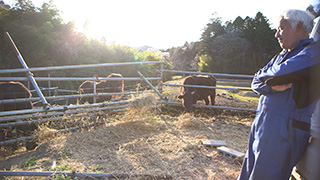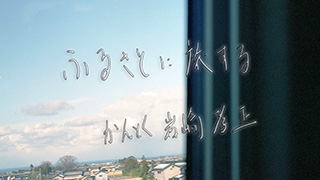Alone Again in Fukushima 2020
(Naoto, ima mo hitorikkiri 2020) JAPAN / 2020 / Japanese / Color / Digital File / 95 min
JAPAN / 2020 / Japanese / Color / Digital File / 95 min
Director, Photography, Editing: Nakamura Mayu
Appearances: Matsumura Naoto, Matsumura Daisuke, Hangai Shinichi, Hangai Toshiko and the animals at Naoto’s farm.
Producer: Yamagami Tetsujiro
Production Companies, Source: Omphalos Pictures, SIGLO
Matsumura Naoto continues to live alone taking care of abandoned animals in Tomioka town in Fukushima Prefecture, which was evacuated after the nuclear accident. This film, a sequel to Alone in Fukushima (2015), which documented his daily life, shows the changes in the country and the town in the eight years since 2013. We see the gradual decrease in the number of animals, along with the unchanging Naoto himself, the couple who entrusted their cows to him, as well as the blossoming of cherry blossoms marking the flow of time. Those who have stayed here look with mixed feelings on people gradually returning after the evacuation order was lifted in some areas.
Her previous work Alone in Fukushima (2015) was screened at Montreal World Film Festival and theatrically released. Alone Again in Fukushima 2021 Theatrical Version will be released at the end of 2021.
My Hometown
(Furusato ni tabi suru) JAPAN, AUSTRIA / 2015–2019 / Japanese, Korean, German / Color, B&W / Digital File / 101 min (Omnibus)
JAPAN, AUSTRIA / 2015–2019 / Japanese, Korean, German / Color, B&W / Digital File / 101 min (Omnibus)
Director, Photography, Editing, Sound: Iwasaki Takamasa
Photography (Nature and Symptoms / From Four Poems): Sebastian Arlamovsky, Simon Graf
Source: Iwasaki Takamasa
An omnibus in three parts by Iwasaki Takamasa, including Nature and Symptoms / From Four Poems which was screened at “Cinema with Us” in YIDFF 2015. Nature and Symptoms / From Four Poems follows an Austrian film crew and two photographers, one from Japan and one from Korea, as they film in Fukushima. Memories is a conversation between a woman and a man with amnesia who moved from Fukushima to Tokyo. Future of the Past visits Minamata, Agano, Yokkaichi, Toyama, and Soma all of which once suffered from pollution, to meet the people who work there. This trilogy depicts the present and memories of Fukushima.
Born in Fukushima Prefecture in 1985, Iwasaki Takamasa started his filmmaking career in earnest after the Great East Japan Earthquake. The three films included in My Hometown have won 10 awards and 17 selections at international film festivals in eight countries.
311 Documentary Film Archive
YIDFF’s 311 Documentary Film Archive collects, catalogs, preserves and provides access to documentary films and related materials about the Great East Japan Earthquake and Tsunami. The archive is in the Yamagata Documentary Film Library, where visitors are able to watch the films at video booths. For more information please see the link below.
For more information ![]() YIDFF “311 Documentary Film Archive” website
YIDFF “311 Documentary Film Archive” website
Cinema with Us 2021: Live Talk Session
Filming the Time—“Post-3.11” and Today
Filmmakers who take on through their continued work the myriad impact of the 3.11 disaster on people’s individual lives, and also on what effect time has had. Hear about what it is like for a filmmaker to interact with a subject for an extended period of time through the medium of film.
- Date:
- Oct. 11th (Mon) 20:00–21:30
- Available for free viewing as a Zoom Webinar
English-Japanese simultaneous interpretation - Panelists:
- Agatsuma Kazuki (Director, Madeleine Dreams, Four Perspectives: A Decade after 3.11)
Kaiko Kiichi (Director, Four Perspectives: A Decade after 3.11)
Nakamura Mayu (Director, Alone Again in Fukushima 2020)
Iwasaki Takamasa (Director, My Hometown) - Moderator:
- Hata Ayumi (Coordinator, Cinema with Us)
